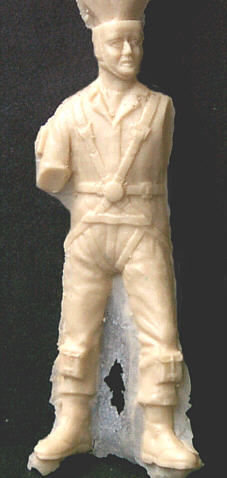|
Construction
Assembly couldn't really be simpler; the are just a few bits of preparation work to do along the way. Firstly, all the parts have to be separated from their sprues and cleaned of all the surplus resin from between the parts. The resin 'flash' is thin and brittle and the bulk of it can be snapped off until close to parts, and then trimmed away with a sharp blade. A distinct mould line is left behind which also has to be scraped or filed away along with any nodules of surplus resin. Lastly, fill any tiny air pockets and rub them down to shape.
The largest part is the 'pilot', which includes his head, body, legs and half his right arm. The arms are semi-posable and after a little light filing match up to the body with no problems - the right one holds on to the control arm for the unit. The mating surface of the backpack unit is well shaped to fit on the pilot's back, and with a little extra superglue applied, this will effectively seal any small gaps.
The points where the rotor blades and counterweights attach to the rotor hubs are indented, but need to be drilled out a little deeper and wider to accept the shafts and achieve a stronger join. The only other piece of equipment is the helmet, which incorporates a pair of goggles moulded on, which needs no extra work and sits neatly on top of the pilot's flat head.
The kit also includes a choice of MP.40 sub-machine gun or Type 60 Anti-Tank Projectile for the pilot to hold in his 'free' hand. The MP.40 needs great care during trimming as it's the most delicate part in the whole kit - although it could be replaced if necessary by any one of a number of plastic, resin or white metal versions on the market!
Accuracy
The figure is well defined and well proportioned and the whole assembly captures the look of the machine in the illustrations. Information about these machines is sparse and the only technical data I found for the 'Heliofly III' was quoted in the Schiffer Military History book 'German Helicopters 1928-1945'. The only relevant dimension is the rotor diameter of 6.10m, but it doesn't state whether this refers to the '57' or '59' version, or whether there was any difference between them. However, the rotor diameter of the kit is only 14cm (3.4") short of the scale dimension.
Colour Options
There is only one colour scheme illustrated of a three-colour German camouflage scheme for the clothing of green, mid-stone and sand. The problem is, that without ready access to the Gunze Sangyo or Italeri paint ranges it is difficult to match the colours with other manufacturers' paints.
Decals
There are no decals contained in this kit as none are needed.
Conclusion & Recommendation
This is a simple but very detailed model in the popular military modelling scale,
ideal for anyone interested in unusual or experimental machines. Its simplicity and ease of construction are well within the capabilities of almost any modeller. I highly recommend this kit - and I'm looking forward to getting my hands on the l/72nd scale version listed in the catalogue!
My thanks to Unicraft for the revue sample.
|



